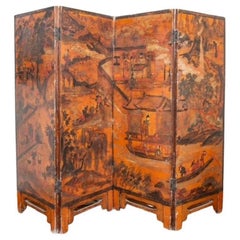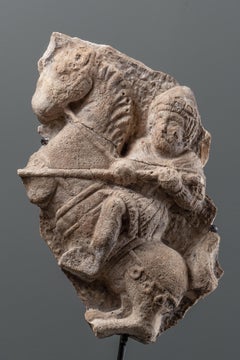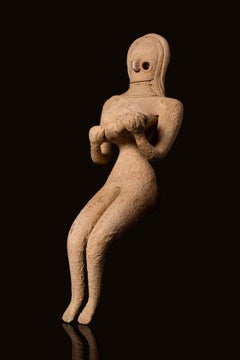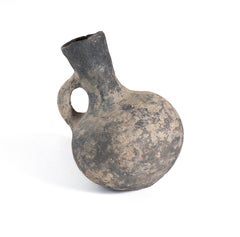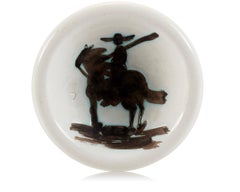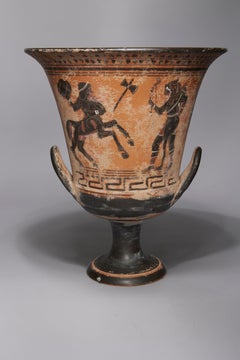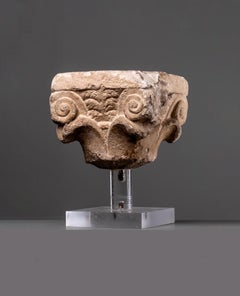15th Century and Earlier More Art
to
4
17
1
3
2
Overall Width
to
Overall Height
to
139
570
4,403
9,796
86
69
267
283
131
309
365
383
419
1,170
73
2
1
9
5
1
3
2
2
1
1
1
1
1
7
5
5
4
4
1
13
10
Period: 15th Century and Earlier
Chimu Inca c.1500 Peruvian terra-cotta anthropomorphic face vase vessel Peru
Located in Wilton Manors, FL
Beautiful antique Peruvian face vessel. Chimu Inca, c.1500 Terracotta, measures h. 8 in., w. 4 7/8 inches. No repair or conservation.
Category
15th Century and Earlier More Art
Materials
Terracotta
$720 Sale Price
60% Off
Antique Chinese Four Leaf Panel Hand-Painted Lacquer Screen
Located in Cirencester, Gloucestershire
Antique Chinese Four-Panel Lacquer Screen with Scenic Landscape
Description:
This exquisite antique Chinese four-panel lacquer screen is a remarkable example of traditional craftsma...
Category
15th Century and Earlier More Art
Materials
Wood
$2,788 Sale Price
30% Off
Limestone Relief With Saint Georges, France 15th Century
Located in Milan, IT
Relief with saint Georges
France, 15th Century
limestone 26 x 20 cm (10 1/4 x 7 3/4 in) without base
Category
15th Century and Earlier More Art
Materials
Limestone
"Roman Mosaic", Tiger hunting for its prey, 4th Century AD North Africa Province
Located in Madrid, ES
ROMAN MOSAIC
Roman 4th Century AD
Roman Provinces of North Africa
A TIGER HUNTING ITS PREY
40-1/4 x 84-1/4 inches (102 x 213 x 2.5 cm.)
Within an iron metal frame
PROVENANCE
Nagel A...
Category
15th Century and Earlier More Art
Materials
Mosaic
Mother Goddess Figurine, Early Indus Valley Civilization (circa 3500 - 2800 BC)
Located in Paris, Île-de-France
Mother Goddess Figurine
Early Indus Valley Civilization (circa 3500 - 2800 BC)
Handmade pottery, 140 mm x 45 mm, 60 g
Provenance:
Prince Collection, 1990s-2014;
Pierre Bergé Colle...
Category
Tribal 15th Century and Earlier More Art
Materials
Clay, Terracotta
Jerusalem, Perfume Vessel, Iron Age
Located in Milwaukee, WI
4x3
Ceramic
Ancient clay perfume jug from the Iron Age discovered in Jerusalem.
Category
15th Century and Earlier More Art
Materials
Ceramic
ITALIAN RENAISSANCE CAPITAL WITH MYTHOLOGICAL FIGURES, 15th Century
Located in Milan, IT
ITALIAN RENAISSANCE CAPITAL WITH MYTHOLOGICAL FIGURES, 15th Century
marble
H 18 x Diam 33.5 cm
H 7 x Diam 13 1/4 in
Category
15th Century and Earlier More Art
Materials
Marble
The Penance of St. Chrysostom by Albrecht Dürer
Located in New Orleans, LA
Albrecht Dürer
1471-1528 German
The Penance of St. Chrysostom
Monogrammed in the plate lower center "AD"
Copper engraving on laid paper
“Whatever was mortal in Albrecht Dürer li...
Category
Old Masters 15th Century and Earlier More Art
Materials
Copper
Ancient Greek Terracotta Comic Actor Figurine
Located in Milan, IT
TERRACOTTA FIGURINE OF A COMIC ACTOR , Greece, c. 350 B.C.
Labeled to the reverse, 'LAWRENCE COLL./LOT 426. SOTHEBY./APR. 1892. P. 816.';
Terracotta
height 15.2 cm
height 6 in
Prove...
Category
15th Century and Earlier More Art
Materials
Terracotta, ABS
ANTIQUE ITALIAN LARGE CIRCULAR FRAGMENT OF A FLUTED COLUMN
Located in Milan, IT
LARGE CIRCULAR FRAGMENT OF A FLUTED COLUMN
Central Italy, 13th century
stone
Category
15th Century and Earlier More Art
Materials
Stone
14th Century Italian Marble Mortar with Animals depicted on the sides
Located in Milan, IT
Unusual 14th Century Italian marble mortar with animals depicted on the sides
Category
15th Century and Earlier More Art
Materials
Marble
Gold Tang China Horse Head
Located in New Orleans, LA
This exceptional and rare rendering of a horse head, composed of gold over silver, hails from the illustrious Tang dynasty of China. The powerful Tang dynasty reigned for nearly 300 ...
Category
Other Art Style 15th Century and Earlier More Art
Materials
Gold, Silver
3rd to 5th Century Coptic Egyptian Textile fragment beige dark blue Brocade
Located in Austin, TX
Textile size 8.5 x 10 in.
Frame size 13.5 x 15 in.
This piece is an ancient Coptic Egyptian textile fragment, dating from the 3rd to 5th century CE. It is composed of a coarse, plai...
Category
15th Century and Earlier More Art
Materials
Textile, Linen, Dye
“The Graduate” Fine Art Print by Laurent Durieux Lithograph Pop Art Contemporary
Located in Draper, UT
Size: 36,5 x 30 cm / 14,37 x 11,81 inches
Limited Edition of 206/300
Signed and numbered by Laurent Durieux
Category
Pop Art 15th Century and Earlier More Art
Materials
Lithograph
Antique Mamluk Qur’anic Manuscript Leaf Folio Maghribi Script 14th-15th Century
Located in London, GB
Antique Mamluk Qur’anic Manuscript Leaf Folio Maghribi Script 14th-15th Century
North African, 14-15th Century
Print: Height 39cm, width 31cm
Frame: Height 73cm, width 62cm, depth 4c...
Category
15th Century and Earlier More Art
Materials
Gold Leaf
$11,342 Sale Price
30% Off
North African Maghribi Manuscript Leaf Gold Illumination, c.15th Century
Located in London, GB
North African Maghribi Manuscript Leaf Gold Illumination, c.15th Century
North African, c. 15th century
Print: Height 39cm, width 31cm
Frame: Height 73cm, width 62cm, depth 4cm
Prod...
Category
15th Century and Earlier More Art
Materials
Gold Leaf
North African Maghribi Manuscript Leaf Gold Illumination, c. 14-15th Cenury
Located in London, GB
North African Maghribi Manuscript Leaf Gold Illumination, c. 14-15th Century
North African, c. 14-15th century
Print: Height 39cm, width 31cm
Frame: Height 73cm, width 62cm, depth 4c...
Category
15th Century and Earlier More Art
Materials
Gold Leaf
Ancient Coptic Egyptian Textile Fragment in Blue, Red, Rust, Brown, Beige, Gold
Located in Austin, TX
Fragment size: 12 x 15 in.
Frame size: 18 x 21 in.
A 4th to 7th Century Coptic Egyptian antique textile fragment of hand woven wool.
In the 4th century AD, Greeks invaded Egypt a...
Category
15th Century and Earlier More Art
Materials
Fabric, Textile, Wool
William the Conqueror Pax Penny
Located in New York, NY
William the Conqueror Pax Penny
English pennies struck in the name of “King William” are the PAXS pennies: these display the letters P A X S (“Peace”) at the intersections of the c...
Category
Medieval 15th Century and Earlier More Art
Materials
Metal
“The Graduate” Fine Art Print by Laurent Durieux Lithograph Pop Art Contemporary
Located in Draper, UT
Size: 36,5 x 30 cm / 14,37 x 11,81 inches
Limited Edition of 206/300
Signed and numbered by Laurent Durieux
Category
15th Century and Earlier More Art
Materials
Lithograph
Pop Art Functional Vessel, Tall Cup
Located in San Diego, CA
One of a kind original functional vessel by local San Diego artist, Ron Carlson.
Category
Pop Art 15th Century and Earlier More Art
Materials
Ceramic
Gallo-Roman Bronze Applique Bust Figure of a Man, 3rd/4th Century A.D.
Located in Milan, IT
PROVENANCE
Herbert A. Cahn (1915-2002), Kunst der Antike, Basel, 1988
Private Collection, Paris
Category
15th Century and Earlier More Art
Materials
Bronze
THREE POLISHED STONE AXE HEADS, BRONZE AGE, ASIA MINOR, CIRCA 3RD MILLENNIUM B.C
Located in Milan, IT
Comprising a greenstone axe head of trapezoid outline, with rounded butt and curved cutting edge, marked in white ink: 'LYDIA', 9.5cm ; another smaller...
Category
15th Century and Earlier More Art
Materials
Stone
Related Items
Picador, Pablo Picasso, Ashtray, Design, Sculpture, Ceramic, White, Edition
Located in Geneva, CH
Picador, Pablo Picasso, Ashtray, Design, Sculpture, Ceramic, White, Edition
Picador
Ed. 500 pcs
1952
White earthenware clay, oxidized paraffin decoration, white enamel
D. 15.2 cm
St...
Category
Post-War 15th Century and Earlier More Art
Materials
Ceramic, Earthenware
$6,863
H 5.99 in W 1.58 in
An Ancient Style Greek Black Figure Calyx Krater, 19th/20th Century
Located in Beachwood, OH
Ancient Style Greek Black Figure Calyx Krater, 19th/20th Century
Terracotta
17 x 14.5 inches
A calyx krater is a type of ancient Greek pottery, specifically a type of krater (a bowl...
Category
15th Century and Earlier More Art
Materials
Terracotta
Scène de Tauromachie, Pablo Picasso, 1957, Plate, Ceramic, Design, Postwar, Toro
Located in Geneva, CH
Scène de Tauromachie, Pablo Picasso, 1957, Plate, Ceramic, Design, Postwar, Toro
Scène de tauromachie
Ed. 500 pcs
1957
Red earthenware clay, engobe decoration, knife engraved
D.24 c...
Category
Post-Modern 15th Century and Earlier More Art
Materials
Ceramic, Clay, Earthenware
$13,239
H 1.19 in Dm 9.45 in
Scène de Tauromachie, Picasso, Edition, 1950's, Bull, Plate, Design, Animal
Located in Geneva, CH
Scène de Tauromachie, Picasso, Edition, 1950's, Bull, Plate, Design, Animal
Scène de tauromachie
Ed. 193/500 pcs
1957
Red earthenware clay, engobe decoration, knife engraved
D.24 cm...
Category
Post-War 15th Century and Earlier More Art
Materials
Ceramic, Earthenware, Terracotta
$13,239
H 9.45 in Dm 1.19 in
Enormous Greek Apulian Red Figure Lekythos, 19th/20th Century
Located in Beachwood, OH
Enormous Greek Apulian Red Figure Lekythos, 19th/20th Century
Terracotta
41 x 15 inches
This has been mended and is showing numerous cracks.
A lek...
Category
15th Century and Earlier More Art
Materials
Terracotta
Vintage French Modernist Jean Lurcat Glazed Ceramic Art Plate Sant-Vicens France
By Jean Lurçat
Located in Surfside, FL
Vintage Jean Lurcat glazed fired enamel wall plaque ceramic plate limited edition hand inscribed faience Ceramique Saint Vicens charger. It depicts a h...
Category
Modern 15th Century and Earlier More Art
Materials
Ceramic, Glaze
Pair of English Regency Blue John (Derbyshire Spar) Urns, 19th Century
Located in Beachwood, OH
Pair of English Regency Blue John (Derbyshire Spar) Urns, 19th Century
9.5 x 3 x 3 inches
Obtained from the Derbyshire England, Blue John is a semi-precious mineral, a rare form of ...
Category
15th Century and Earlier More Art
Materials
Marble
$9,500
H 9.5 in W 3 in D 3 in
Small Cat Color Red, 2022
By Linda Smith
Located in Santa Monica, CA
Not Available
Category
15th Century and Earlier More Art
Materials
Ceramic
Pablo Picasso, Hibou rouge sur fond noir (A.R. 399)
Located in Madrid, ES
PABLO PICASSO (1881-1973)
Hibou rouge sur fond noir (A.R. 399)
stamped, marked and numbered 'Madoura Plein Feu / Edition Picasso / N 103 / Edition Picasso / 1/150 / Madoura' (underne...
Category
Modern 15th Century and Earlier More Art
Materials
Terracotta
Mid Century Carved Figurative Girl and Kitten
Located in Soquel, CA
Mid century carved marble figurative girl and kitten by Rodney Marshall Winfield (American, b. 1925). Presented in rustic wood frame. Bio on verso. Image, 14"H x 10"W.
Rodney studied at Cooper Union School in New York and worked as a designer at the Emil Frei...
Category
Folk Art 15th Century and Earlier More Art
Materials
Marble
Basket, Wounaan Tribe Panama Darien Rainforest, gold, black, red, white
Located in Santa Fe, NM
Basket, Wounaan Tribe Panama Darien Rainforest, gold, black, red, white
Category
Tribal 15th Century and Earlier More Art
Materials
Organic Material
Ancient Greek Terracotta Comic Actor Figurine
Located in Milan, IT
TERRACOTTA FIGURINE OF A COMIC ACTOR , Greece, c. 350 B.C.
Labeled to the reverse, 'LAWRENCE COLL./LOT 426. SOTHEBY./APR. 1892. P. 816.';
Terracotta
height 15.2 cm
height 6 in
Prove...
Category
15th Century and Earlier More Art
Materials
Terracotta, ABS
Previously Available Items
Carved, Gilt and Painted 15th century Tibetan Book Cover
Located in SANTA FE, NM
Carved, Gilt and Painted Book Cover
Tibet, circa 15th century
Carved, gilt and painted wood
29 x 9 x 1 1/4 (35 x 15 x 2 1/2 on its mount)
This is a fine example of one half of a pa...
Category
15th Century and Earlier More Art
Materials
Gold Leaf
ITALIAN MEDIEVAL CAPITAL, 12th/13th Century
Located in Milan, IT
ITALIAN MEDIEVAL CAPITAL
Italy, 12th/13th Century
marble
19 x 23 x 23 cm
7 1/2 x 9 x 9 in
total height 31 cm (12 1/4 in)
Category
15th Century and Earlier More Art
Materials
Marble
ANTIQUE ITALIAN WINDOW MULLION FRAGMENT (BIFORA), 14TH CENTURY
Located in Milan, IT
Window Mullion Fragment (Bifora), 14th Century
58 x 50 x 14 cm
22 3/4 x 19 3/4 x 5 1/2 in
Category
15th Century and Earlier More Art
Materials
Marble
H 22.84 in W 19.69 in D 5.52 in
A late Hellenistic Ionic Marble Capital Greek Empire 2nd Century AD
Located in Milan, IT
PROVENANCE
J.E. Private Collection, Bavaria, 1960s
Category
15th Century and Earlier More Art
Materials
Travertine
H 8.67 in W 15.36 in D 15.36 in
Chimu c.1100 Peruvian terra-cotta portrait face vase vessel Peru
Located in Wilton Manors, FL
Beautiful pre-Columbian Chimu vessel. Terracotta, a.d. 1100-1400, Peru. One very minor chip under rim of vessel opening. Otherwise outstanding condition.
Category
15th Century and Earlier More Art
Materials
Terracotta
H 8.75 in W 5.88 in D 5.5 in
Chimu Peruvian pre-Columbian pottery figural face vessel Peru
Located in Wilton Manors, FL
Beautiful Peruvian relief figural vessel. Chimu, circa. A.D. 1000. Measures h. 8.75 inches, w. 5.5 inches. No damage or conservation.
Category
15th Century and Earlier More Art
Materials
Terracotta
RAW EDGE ONYX BOWL II
Located in Tulsa, OK
This Raw Edge Onyx Bowl is a white, cream, brown, grey, and yellow natural onyx contemporary design piece that measures 21 x 16 and is priced at $275.
Exhibit by Aberson has been se...
Category
Contemporary 15th Century and Earlier More Art
Materials
Precious Stone
Antique Bible Leaf
Located in Houston, TX
Exquisitely executed incunabula bible leaf rich with history from the Missale Ratisponense, 1500. Over 500 years old.
Original artwork on paper displayed o...
Category
15th Century and Earlier More Art
Materials
Ink, Parchment Paper
Hu with a Chain
Located in Palm Desert, CA
Chinese bronze Hu from Zhou dynasty
Category
Other Art Style 15th Century and Earlier More Art
Materials
Bronze
Buddhist Embroidery
Located in Palm Desert, CA
Category
15th Century and Earlier More Art
Recently Viewed
View AllMore Ways To Browse
Grouse Shooting
Harry Adams
Harry Day Paintings
Harvey Parks
Hedge House
Henry Collins
Hermes Birkin Bag 15
Highland Cow Painting
Hippo Painting
Hoppe Oil
Horse And Groom Painting
Horse Hunt Painting
Horse Lady Painting
Horse Painting Gold Frame
Horse Polo Paint
Hunt Double Bunnies
Hunt Etchings
Hunt Slonem Bunnies Heart
